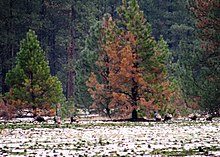Little Pend Oreille National Wildlife Refuge
| Little Pend Oreille National Wildlife Refuge | |
|---|---|
IUCN category IV (habitat/species management area) | |
 | |
| Location | Pend Oreille and Stevens counties, Washington, United States |
| Nearest city | Colville, Washington |
| Coordinates | 48°27′44″N 117°39′19″W / 48.46222°N 117.65528°W[1] |
| Area | 42,593.57 acres (172.3701 km2)[2] |
| Established | 1939[3] |
| Governing body | U.S. Fish and Wildlife Service |
| Website | Little Pend Oreille National Wildlife Refuge |
The Little Pend Oreille National Wildlife Refuge is a wildlife preserve, one of the national wildlife refuges operated by the United States Fish and Wildlife Service. The refuge is located east of Colville, Washington, along the west slope of the Selkirk Mountain Range. It lies mostly in eastern Stevens County, with a small part extending eastward into western Pend Oreille County. It is the only mountainous, mixed-conifer forest refuge outside Alaska[4] and the largest in Washington state.
Wildlife found in the refuge include numerous songbirds, bald eagles, elk, black bears, timber wolves, cougars, moose, beavers, and white-tailed deer.
Public uses include hunting, fishing, hiking, camping, and horseback riding.[4]
Gallery
[edit]-
View of a gorge in the refuge
-
Refuge landscape
-
Farmhouse on the refuge
References
[edit]![]() This article incorporates public domain material from websites or documents of the United States Fish and Wildlife Service.
This article incorporates public domain material from websites or documents of the United States Fish and Wildlife Service.
- ^ "Little Pend Oreille National Wildlife Refuge". Geographic Names Information System. United States Geological Survey, United States Department of the Interior.
- ^ "Annual Report of Lands as of September 30, 2013" (PDF). United States Fish and Wildlife Service.
- ^ "About the Refuge". Little Pend Oreille National Wildlife Refuge. U.S. Fish and Wildlife Service.
- ^ a b "Little Pend Oreille National Wildlife Refuge Profile". U.S. Fish and Wildlife Service.
External links
[edit]- Little Pend Oreille National Wildlife Refuge U.S. Fish and Wildlife Service
- Friends of the Little Pend Oreille National Wildlife Refuge




